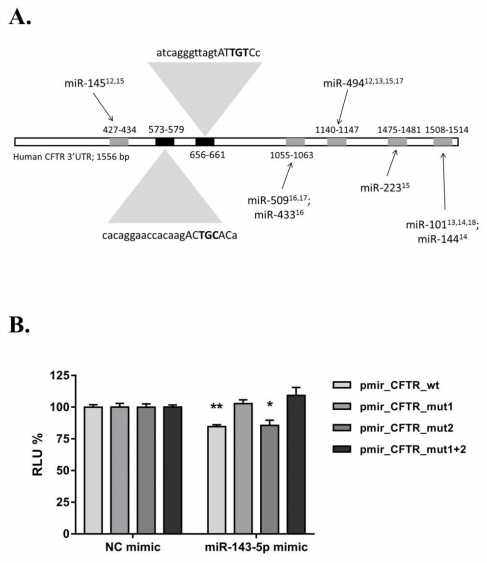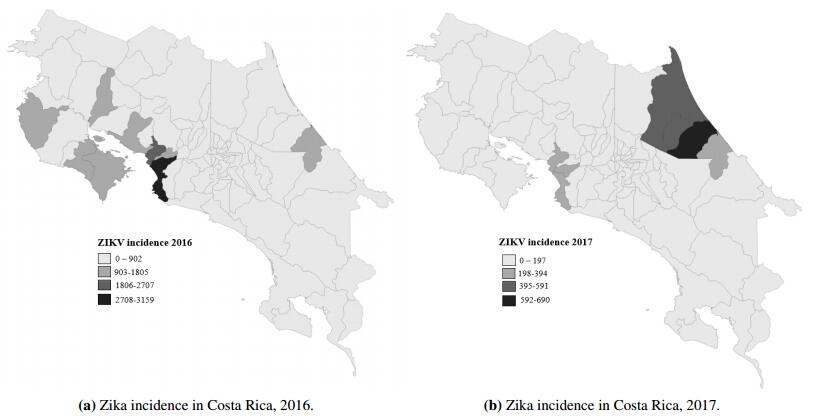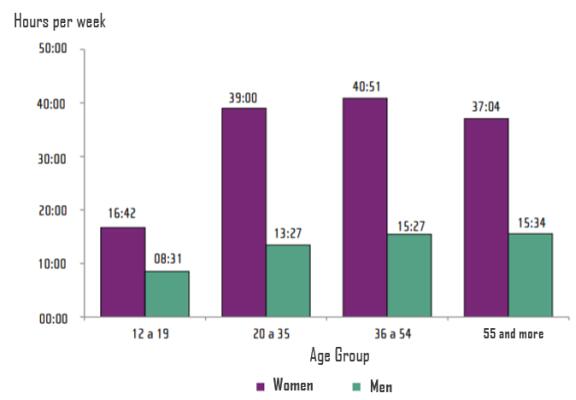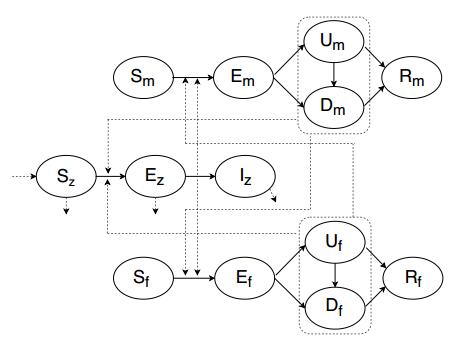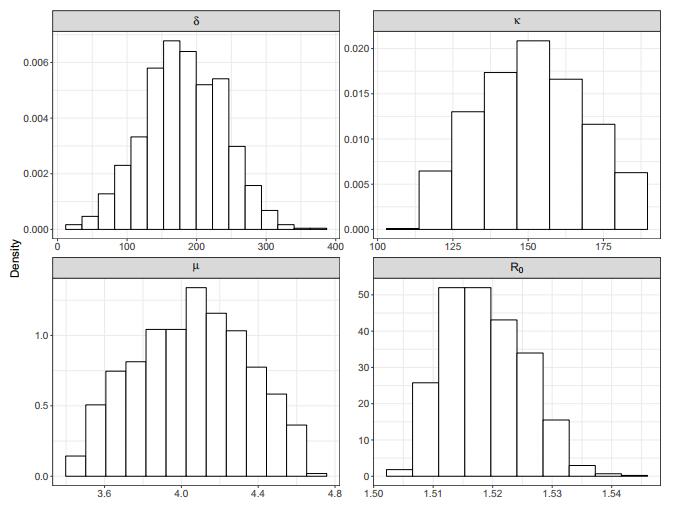|
[1]
|
D. J. Gubler, Resurgent vector-borne diseases as a global health problem, Emerging Infect. Dis., 4 (1998), 442–450.
|
|
[2]
|
T. Shragai, B. Tesla, C. Murdock, et al., Zika and Chikungunya: mosquito-borne viruses in a changing world, Ann. N. Y. Acad. Sci., 1399 (2017), 61–77.
|
|
[3]
|
G. W. Dick, S. F. Kitchen and A. J. Haddow, Zika virus isolations and serological specificity, Trans. R. Soc. Trop. Med. Hyg., 46 (1952), 509–519.
|
|
[4]
|
World Health Organization: Zika strategic response plan quarterly update, 2016. Available from: http://www.who.int/emergencies/zika-virus/quarterly-update-october/en/.
|
|
[5]
|
D. Musso and D. J. Gubler, Zika virus, Clin. Microbiol. Rev., 29 (2016), 487–524.
|
|
[6]
|
B. Song, S. Yun, M. Woolley, et al., Zika virus: History, epidemiology, transmission, and clinical presentation, J. Neuroimmunol., 308 (2017), 50–64.
|
|
[7]
|
Pan American Health Organization: Zika cases and congenital syndrome associated with Zika virus reported by countries and territories in the Americas, 2015–2018. Cumulative cases, 2018. Available from: http://www.paho.org/hq/index.php?option=com_ docman&view=download&category_slug=cumulative-cases-pdf-8865&alias=43296- zika-cumulative-cases-4-january-2018-296&Itemid=270&lang=en.
|
|
[8]
|
S. A. Rasmussen, D. E. Jamieson, M. A. Honein, et al., Zika virus and birth defects reviewing the evidence for causality, N. Engl. J. Med., 374 (2016), 1981–1987.
|
|
[9]
|
A. B. Blázquez and J. C. Saiz, Neurological manifestations of Zika virus infection, World J. Virol., 5 (2016), 135–143.
|
|
[10]
|
L. R. Peterson, D. J. Jamieson, A. M. Powers, et al., Zika virus, N. Engl. J. Med., 374 (2016), 1552–1563.
|
|
[11]
|
M. Besnard, S. Lastere, A. Teisser, et al., Evidence of perinatal transmission of Zika virus, French Polynesia, December 2013 and February 2014, Euro Surveill., 13 (2014).
|
|
[12]
|
P. Brasil, J. P. Pereira, M. E. Moreira, et al., Zika virus infection in pregnant women in Rio de Janeiro, N. Engl. J. Med., 375 (2016), 2321–2334.
|
|
[13]
|
G. Calvet, R. S. Aguilar, A. S. Melo, et al., Detection and sequencing of Zika virus from amniotic fluid of fetuses with microcephaly in Brazil: a case study, Lancet Infect. Dis., 16 (2016), 653–660.
|
|
[14]
|
E. M. Bloch, P. M. Ness, A. A. Tobian, et al., Revising blood safety practices given emerging data about Zika virus, N. Engl. J. Med., 378 (2018), 1837–1841.
|
|
[15]
|
C. J. Gregory, T. Oduyebo, A. C. Brault, et al., Modes of transmission of Zika Virus, J. Infect. Dis., 10 (2017), 875–883.
|
|
[16]
|
L. J. Yockey, L. Varela, T. Raxib, et al., Vaginal exposure to Zika virus during pregnancy leads to fetal brain infection, Cell, 166 (2016), 1247–1256.
|
|
[17]
|
C. L. Althus and N. Low, How relevant is sexual transmission of Zika virus? PLoS Med., 13 (2016).
|
|
[18]
|
O. Maxian, A. Neufeld, E. J. Tails, et al., Zika virus dynamics: When does sexual transmission matter?, Epidemics, 21 (2017), 48–55.
|
|
[19]
|
D. Gao, Y. Lou, T. C. Porco, et al., Prevention and control of Zika as a mosquito-borne and sexually transmitted disease: A mathematical modeling analysis, Sci. Rep., 6 (2016).
|
|
[20]
|
A. Allard, B. M. Althouse, L. Hébert-Dufresne, et al., The risk of sustained sexual transmission of Zika is underestimated, PLoS Pathog., 13, (2017).
|
|
[21]
|
M. R. Duffy, T. Chen, W. T. Hancock, et al., Zika virus outbreak on Yalp Island, Federated States of Micronesia, N. Engl. J. Med., 360 (2009), 2536–2543.
|
|
[22]
|
E. S. Paixao,W. Y. Leong, L. C. Rodrigues, et al., Asymptomatic prenatal Zika virus infection and Congenital Zika Syndrome, Open Forum. Infect. Dis., 5 (2018).
|
|
[23]
|
J. N. Eisenberg, M. A. Brookhart, G. Rice, et al., Disease transmission models for public health decision making: Analysis of epidemic and endemic conditions caused by waterborne pathogens, Environ. Health Perspect., 110 (2002), 783–790.
|
|
[24]
|
P. van den Driessche, Reproduction numbers of infectious disease models, Infect. Dis. Model., 2 (2017), 288–303.
|
|
[25]
|
S. Basu and J. Andrews, Complexity in mathematical models of public health policies: A guide for consumers of models, PLoS Med., 10 (2013).
|
|
[26]
|
G. MacDonald, The analysis of the sporozoite rate, Trop. Dis. Bull., 49 (1952), 569–586.
|
|
[27]
|
K. Dietz, The estimation of the basic reproduction number for infectious diseases, Stat. Methods Med. Res., 2 (1993), 23–41.
|
|
[28]
|
G. Chowell, N.W. Hengartner, C. Castillo-Chavez, et al., The basic reproductive number of Ebola and the effects of public health measures: the cases of Congo and Uganda, J. Theor. Biol., 229 (2004), 119–126.
|
|
[29]
|
M. Nuño, G. Chowell and A. Gumel, Assessing basic control measures, antivirals and vaccine in curtailing pandemic influenza: Scenarios for the US, UK, and the Netherlands, J. R. Soc. Interface, 4 (2007), 505–521.
|
|
[30]
|
F. Brauer and G. Chowell, On epidemic growth rates and the estimation of the basic reproduction number. Notes on modeling and numerical methods. Computational modeling of biological systems, M. A. Morales Vazquez and S. Botello Rionda (eds.), CIMAT (2012).
|
|
[31]
|
G. Chowell, R. Fuentes, A. Olea, et al., The basic reproduction number R0 and effectiveness of reactive interventions during dengue epidemics: The 2002 dengue outbreak in Easter Island, Chile, Math. Biosci. Eng., 10 (2013), 1455–1474.
|
|
[32]
|
C. L. Althaus, Estimating the reproduction number of Ebola virus (EBOV) during the 2014 outbreak in West Africa, PLoS Curr., 1 (2014).
|
|
[33]
|
S. Towers, F. Brauer, C. Castillo-Chavez, et al., Estimate of the reproduction number of the 2015 Zika virus outbreak in Barranquilla, Colombia, and estimation of the relative role of sexual transmission, Epidemics, 17 (2016), 50–55.
|
|
[34]
|
Instituto Nacional de Estadística y Censos, Costa Rica en cifras, 2018, Available from: http://www.inec.go.cr/sites/default/files/documetos-biblioteca- virtual/recostaricaencifras2018.pdf.
|
|
[35]
|
A. I. Aguilera and M. Garcia, Estudio de la urbanización en Centroamérica: Oportunidad de una Centroamérica urbana, 2018, Available from:http://documentos.bancomundial. org/curated/es/811611517808775995/pdf/113554-PUB-SPANISH-date-2-6-2018- PUBLIC.pdf.
|
|
[36]
|
J. Solano and R. Villalobos, Regiones y subregiones climáticas de Costa Rica, 2000. Available from: https://www.imn.ac.cr/documents/10179/20909/Regionalizaci.%C3%B3n+ clim%C3%A1tica+de+Costa+Rica
|
|
[37]
|
L. A. Guzmán, El cambio climático: Causas, consecuencias y la reducción de riesgos de desastre de Cruz Roja Costarricense, 1st edition, Dirección Nacional de Socorros y Operaciones Cruz Roja Costarricense, San José (2009).
|
|
[38]
|
A. Morice, R. Marin, M. L. Ávila, El dengue en Costa Rica, evolución histórica, situación actual y desafíos, La Salud Pública en Costa Rica. Estado actual, retos y perspectivas, (2010), 197–217.
|
|
[39]
|
Ministerio de Salud de Costa Rica, Análisis de situación de salud, 2018, Available from: http://www.ministeriodesalud.go.cr/index.php/vigilancia-de-la-salud/ analisis-de-situacion-de-salud.
|
|
[40]
|
Presidencia de la República de Costa Rica, Primer caso importado de Zika en Costa Rica 2016. Available from: http://presidencia.go.cr/comunicados/2016/01/primer-caso- importado-de-zika-en-costa-rica/.
|
|
[41]
|
L. H. Chen, Zika virus infection in a Massachusetts resident after travel to Costa Rica: a case report, Ann. Intern. Med., 164 (2016), 574–576.
|
|
[42]
|
La Nación, Embarazada se convierte en primer caso autóctono de zika en Costa Rica 2016. Available from: https://www.nacion.com/el-pais/salud/embarazada-se-convierte-en- primer-caso-autoctono-de-zika-en-costa-rica/PSI4Z6V75ZGARLKBA62NAH6INA/ story/.
|
|
[43]
|
Instituto Costarricense de Investigación y Enseñanza en Nutrición y Salud. Centro Nacional de Referencia de Virología: Informe de vigilancia de Arbovirus basada en laboratorio. Análisis de datos de Zika, Dengue, Chikungunya y Mayaro Costa Rica, 2017, 2017. Available from: http: //www.inciensa.sa.cr/vigilancia_epidemiologica/informes_vigilancia/2017/ Virologia/Informe.%20de%20vigilancia%20anual%20de%20Arbovirus%202017.pdf.
|
|
[44]
|
Instituto Costarricense de Investigación y Enseñanza en Nutrición y Salud. Centro Nacional de Referencia de Virología., Informe de vigilancia de arbovirus basada en laboratorio. Análisis de datos de Zika, Dengue, Chikungunya, Mayaro y Fiebre Amarilla. Costa Rica, Primer Semestre 2018, 2018, Available from: http://www.inciensa.sa.cr/vigilancia_epidemiologica/ informes_vigilancia/2018/Virologia/Informe%20semestral%20Arbovirus%202018. pdf.
|
|
[45]
|
Instituto Costarricense de Investigación y Enseñanza en Nutrición y Salud. Centro Nacional de Referencia de Virología: Informe de vigilancia de arbovirus basada en laboratorio, 2016, Available from: http://inciensa.sa.cr/vigilancia_epidemiologica/informes_vigilancia/ 2016/Virologia/Informe.%20vigilancia%20Arbovirus%202016.pdf.
|
|
[46]
|
Z. Feng and J. X. Velasco-Hernández, Competitive exclusion in a vector-host model for the dengue fever, J. Math. Biol., 35 (1997), 423–544.
|
|
[47]
|
L. Esteva and C. Vargas, Analysis of a dengue disease transmission model, Math. Biosci., 150 (1997), 131–151.
|
|
[48]
|
L. Esteva and C. Vargas, A model for dengue disease with variable human population, J. Math. Biol., 38 (1999), 220–240.
|
|
[49]
|
S. Lee and C. Castillo-Chavez, The role of residence times in two-patch dengue transmission dynamics and optimal strategies, J. Theor. Biol., 374 (2015), 152–164.
|
|
[50]
|
F. Brauer, C. Castillo-Chavez and A. Mubayi, et al., Some models for epidemics of vectortransmitted diseases, Infect. Dis. Model., 1 (2016), 79–87.
|
|
[51]
|
F. Sanchez, M. Engman and L. C. Harrington, et al., Models for dengue transmission and control, in Mathematical Studies on Human Disease Dynamics Emerging Paradigms and Challenges 410, (Eds. A. Gumel, C. Castillo-Chavez, R.E. Mickens and D.P. Clemence), Contemporary Mathematics, (2006), 311–326.
|
|
[52]
|
F. Sanchez, D. Murillo and C. Castillo-Chavez, Change in host behavior and its impact on the transmission dynamics of dengue, in International Symposium on Mathematical and Computational Biology, (Eds. R. P. Mondaini), BIOMAT 2011 (2012), 191–203.
|
|
[53]
|
D. Murillo, S. A. Holechek, A. L. Murillo, et al., Vertical transmission in a two-strain model of dengue fever, Lett. Biomath., 1 (2014), 249–271.
|
|
[54]
|
C. A. Manore, K. S. Hickmann, S. Xu, et al., Comparing dengue and chikungunya emergence and endemic transmission in A. aegypti and A. albopictus, J. Theor. Biol., 356 (2014), 174-191.
|
|
[55]
|
O. Olawoyin and C. Kribs, Effects of multiple transmission pathways on Zika dynamics. Infect. Dis. Model., 3 (2018), 331–344.
|
|
[56]
|
G. Cruz, L. Esteva and C. Pio, A mathematical analysis of zika virus epidemic in Rio de Janeiro as a vector-borne and sexually transmitted disease, J. Biol. Syst., 27 (2019).
|
|
[57]
|
B. Tesla, L. R. Demakovsky, H. S. Packiam, et al., Estimating the effects of variation in viremia on mosquito susceptibility, infectiousness, and R0 of Zika in Aedes aegypti, PLoS Negl. Trop. Dis., 12 (2018).
|
|
[58]
|
A. Gordon, L. Gresh, S. Ojeda, et al., Prior dengue virus infection and risk of Zika: A pediatric cohort in Nicaragua, PLoS Med., 16 (2019).
|
|
[59]
|
T. Ferdousi, L. W. Cohnstaedt, D. S. McVey, et al., Understanding the survival of Zika virus in a vector interconnected sexual contact network, bioRxiv, (2019).
|
|
[60]
|
A. Sanchez, D. Pou, E. Sulleiro, et al., Zika virus dynamics in body fluids and risk of sexual transmission in a nonendemic area, Trop. Med. Int. Health, 23 (2017), 92–100.
|
|
[61]
|
D. J. Gubler, Dengue and Dengue Hemorrhagic Fever, Clin. Microbiol. Rev., 11, (1998), 480–496.
|
|
[62]
|
D. D. Chadee, Resting behaviour of Aedes aegypti in Trinidad: with evidence for the reintroduction of indoor residual spraying (IRS) for dengue control, Parasit Vectors, 6, (2013), 255–260.
|
|
[63]
|
L. C. Harrington, T.W. Scott, K. Lerdthusnee, et al., Dispersal of the dengue vector Aedes aegypti within and between rural communities, Am. J. Trop. Med. Hyg., 72 (2005), 209–220.
|
|
[64]
|
H. F. Schoof, Mating, resting habits and dispersal of Aedes aegypti, Bull. World Health Organ., 36 (1967), 600–601.
|
|
[65]
|
L. C. Harrington, A. Fleisher, D. Ruiz, et al., Heterogeneous Feeding Patterns of the Dengue Vector, Aedes aegypti, on Individual Human Hosts in Rural Thailand, PLoS Neglect. Trop. Dis., 8 (2014).
|
|
[66]
|
K. A. Liebman, S. T. Stoddard, R. C. Reiner, et al., Determinants of Heterogeneous Blood Feeding Patterns by Aedes aegypti in Iquitos, Peru, PLoS. Neglect. Trop. Dis., 8 (2014).
|
|
[67]
|
Instituto Nacional de Estadística y Censos, Encuesta Nacional de Uso del Tiempo 2017, Resultados Generales 2018, Available from: http://www.inec.go.cr/sites/default/files/ documetos-biblioteca-virtual/reenut2017.pdf.
|
|
[68]
|
O. Diekmann, J. A. P. Heesterbeek and J. A. J. Metz, On the definition and the computation of the basic reproduction ratio R0 in models for infectious diseases in heterogeneous populations, J. Math. Biol., 28 (1990), 365–382.
|
|
[69]
|
S. Sisson, Y. Fan and M. Beaumont, Handbook of Approximate Bayesian Computation, CRC Press, (2019).
|
|
[70]
|
F. Sanchez, L. A. Barboza, D. Burton, et al., Comparative analysis of dengue versus chikungunya outbreaks in Costa Rica, Ric. Mat., 67 (2018), 163–174.
|
|
[71]
|
J. Holland, Adaptation in natural and artificial systems: an introductory analysis with applications to biology, control and artificial intelligence, MIT Press, Cambridge, UK, 1992.
|
|
[72]
|
L. Scrucca, GA: A package for genetic algorithms in R, J. Stat. Softw., 53 (2013).
|
|
[73]
|
R. H. Byrd, P. Lu, J. Nocedalt, et al., A limited memory algorithm for bound constrained optimization, < i>SIAM J. Sci. Comput., 16 (1995), 1190–1208.
|
|
[74]
|
J. K. Pritchard, M. T. Seielstad and M.W. Feldman, Population growth of human Y chromosomes: a study of Y chromosome microsatellites, Mol. Biol. Evol., (1998), 1791–1798.
|
|
[75]
|
F. Jabot, T. Faure and N. Dumoulin, EasyABC: Performing efficient approximate Bayesian computation sampling schemes using R, Methods Ecol. Evol., 4 (2013), 684–687.
|
|
[76]
|
Instituto Nacional de Estadística y Censos, Encuesta Continua de Empleo al segundo trimestre de 2018 2018. Available from: http://www.inec.go.cr/sites/default/files/documetos- biblioteca-virtual/reeceiit2018.pdf.
|
|
[77]
|
L. Arriola and J. M. Hyman, Sensitivity analysis for uncertainty quantification in mathematical models, in Mathematical and Statistical Estimation Approaches in Epidemiology (Eds. Chowell, G., et al.), Springer, Berlin (2009).
|
|
[78]
|
Ministerio de Salud, Lineamientos Nacionales para el control del Dengue, 2010. Available from: http://www.solucionesss.com/descargas/G-.%20Leyes/LINEAMIENTOS_ NACIONALES_PARA_EL_CONTROL_DEL_DENGUE.pdf
|
|
[79]
|
A. Troyo, Analyses of dengue fever and Aedes aegypti (Diptera: Culicidae) larval habitats in a tropical urban environment of Costa Rica using geospatial and mosquito surveillance technologies Ph.D thesis, University of Miami, 2007. Available from: https://scholarlyrepository.miami.edu/cgi/viewcontent.cgi?referer=https: //www.google.com/&httpsredir=1&article=1017&context=oa_dissertations.
|
|
[80]
|
A. B. Knudsen and R. Slooff, Vector-borne disease problems in rapid urbanization: new approaches to vector control, Bull. World Health Organ., 70 (1992), 1–6.
|
|
[81]
|
World Health Organization Dengue: Guidelines for Diagnosis, Treatment, Prevention and Control: New Edition, 2009. Available from: https://apps.who.int/iris/bitstream/handle/ 10665/44188/9789241547871_eng.pdf?sequence=1&isAllowed=y.
|
|
[82]
|
Instituto Nacional de Estadística y Censo,Características de las viviendas, 2011. Available from: http://www.inec.go.cr/sites/default/files/documentos/inec_institucional/ estadisticas/resultados/reviviendcenso2011-06.pdf.pdf.
|
|
[83]
|
Ministerio de Salud, Lineamientos Nacionales para el abordaje integral de la mujer embarazada y el recin nacido, relacionado con la infección del ZIKA, 2016. Available from: https://www.ministeriodesalud.go.cr/index.php/biblioteca-de-archivos/3054- lineamientos-nacionales-para-el-abordaje-integral-de-la-mujer-embarazada- y-el-recien-nacido-relacionado-con-la-infeccion-del-zika/file.
|
|
[84]
|
Instituto Costarricense de Investigación y Enseñanza en Nutrición y Salud. Centro Nacional de Referencia de Virología., Informe abreviado de los casos de microcefalia reportados al CREC,Costa Rica, 2011-2017, 2018. Available from: http://inciensa.sa.cr/vigilancia_ epidemiologica/informes_vigilancia/2018/Malformaciones.%20Congenitas/ Reporte%20abreviado%20de%20Microcefalia%20en%20Costa%20Rica%202011- 2017.pdf.
|
|
[85]
|
C. J. Carlson, E. Dougherty, M. Boots, et al., Consensus and conflict among ecological forecasts of Zika virus outbreaks in the United States, Sci. Rep., 8 (2018), 1–15.
|
|
[86]
|
M. A. Honein, Recognizing the global impact of zika virus infection during pregnancy, N. Engl. J. Med., 378 (2018), 1055–1056.
|
|
[87]
|
D. Juarbe, A. Obén, R. Santoni, et al., Using risk communication strategies for zika virus prevention and control driven by community-based participatory research, Int. J. Environ. Res. Public Health, 15 (2018), 2–11.
|
|
[88]
|
P. Winch, C. Kendall and D. Gubler, Effectiveness of community participation in vector-borne disease control, Health Policy Plan., 7 (1993), 342–351.
|
|
[89]
|
Lt. Col. M. S. Mustafa and B. R. Ramasethu, Zika: An enormous public health challenge for a miniscule virus, Med. J. Armed. Forces India, 74 (2018), 61–64.
|
|
[90]
|
N. Mena, A. Troyo, R. Bonilla, et al., Factores asociados con la incidencia de dengue en Costa Rica, Revista Panam. Salud Publica, 29 (2011), 234–242.
|
|
[91]
|
R. Barrera, N. Delgado, M. Jiménez, et al., Estratificación de una ciudad hiperendémica en dengue hemorrágico, Revista Panam. Salud Publica, 8 (2000), 225–233.
|









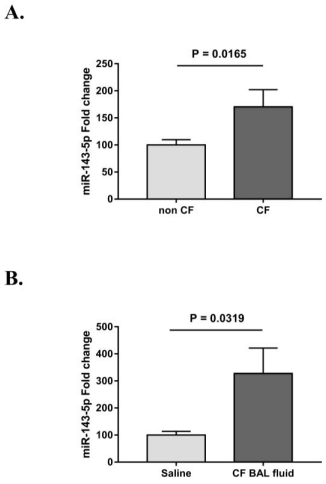
 DownLoad:
DownLoad: 